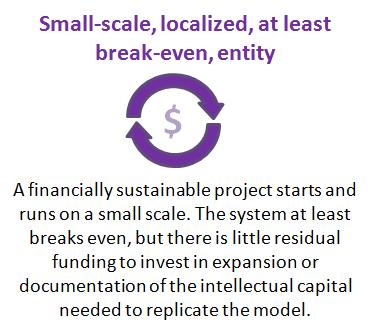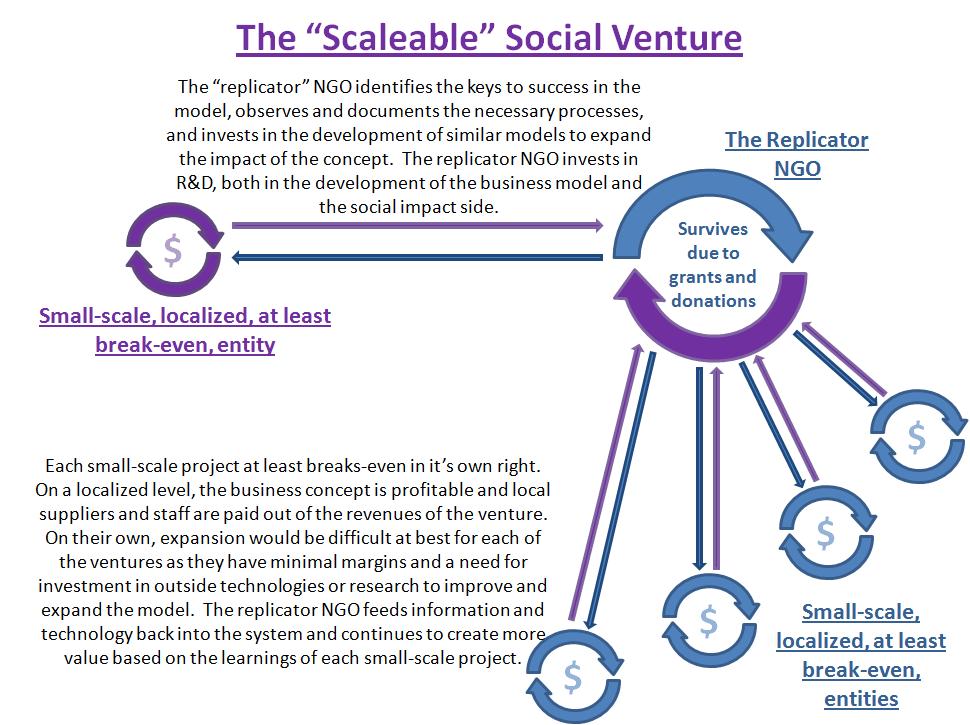The Social Venture “Scalability” Model
Are there any “scalable” & profitable social ventures? There is talk of “social ventures” being our saviors from the likes of the non-profit world. Do they REALLY exist? Or are they mostly hybrid models which still rely heavily on their non-profit arms in order to succeed at scale?
It is VERY hard to find examples which fit all three of these criteria: social venture, scaled beyond it’s initial area of impact, and profitable. We have all heard of Kiva and Grameen, Friedman congratulates Digital Divide Data, and we will all soon know about SHE (Sustainable Health Enterprises), but none of these fit the bill entirely. They are all innovative models, but I think there is a growing misconception that there is a huge social venture movement which is led by groups which are funding their work via markets and are impacting development work without relying on donations. If you subscribe to the newsletters of the above example groups, you know that each rely heavily on donations to improve the social impact of their work or to scale their models.
In essence, many of them start like this:
For Digital Divide Data, that break even entity is one of their data entry company locations in South East Asia. Each makes enough money to pay employees and cover operational overhead. But what about R&D for the technology they need to expand their work or funds to cover the school scholarships they offer their employees? SHE will help factories start which will not only break even but will eventually bring in profits for the women who will become full-owners in their plant. But here too, R&D as well as health education will likely not be able to be funded to the extent needed via this model. KIVA is entirely a non-profit with their operations and overhead funded through donations from lenders and other investors.
Most groups expand with a non-profit arm, here called “The Replicator NGO” which relies on donations to scale and support the model:
Each localized venture on its own is at least breaking even, and there might be net profit enough to expand slightly, but often times the idea of “scaling” something to a much larger area requires R&D, systems design, and a larger investment of both time and money than the local project can generate. Many new social ventures run like any start-up would, constantly in bootstrap and catch-up modes, expending nearly all their time and money resources in the DOING part of their work with little left to allocate towards strategic planning/documenting/scaling.
What does this say to me? This says we SHOULDN’T hold the false ideal of financial sustainability and completely cutting the strings of non-profit donations as the ultimate goal. These groups and others have proven that a hybrid model is just as, if not more successful at impacting positive global change while also filling needs in the traditional market economy sense.
Grameen might be the best example of why we shouldn’t set financial sustainability as the ultimate goal. Check out what Grameen Foundation does. THAT is the success of their model – building human capacity, investing in improving systems, connecting and educating organizations and people…. not just giving out loans. Others have copied the loan model, but forgotten to read further into their model which involves vetting projects before investment, creating solidarity groups among borrowers, etc. It can be argued that taking their model and NOT taking the non-profit side of what they do can be more harmful in the long run.
So, I ask two things of you:
1) contemplate on the fact that maybe complete financial sustainability might not be a feasible or the best solution for the problems facing our world, and then comment on that below
or
2) give some examples of social ventures which fit all three categories: social venture, scaled beyond initial area of impact, and profitable – and add them to the comments below
Thanks for reading and thinking about this!
“Are there any “scalable” & profitable social ventures?”: This question is the main topic of an ongoing conversation I have had with many of my friends and co-workers. The thoughts and (poor) images I came up with above are mostly based on discussions I have recently had with Tim Rann (of PEPY) and Rafe Furst.
A quick and easy answer would be what I’ll call for now “intellectual scaling” – the sharing of impact through the sharing of ideas. The emergence of a range of Web 2.0 technology based sites, on-line supported initiatives, and conferences and trainings surrounding information sharing can probably tick all three boxes. I’d love to learn of and from other examples outside of just information sharing initiatives.


